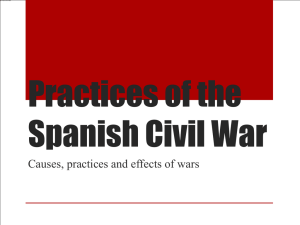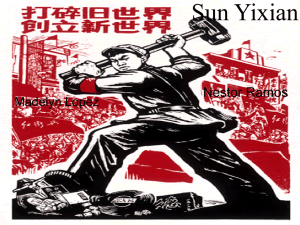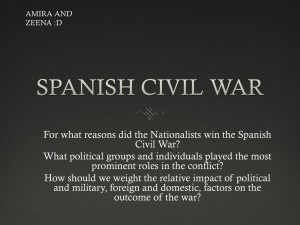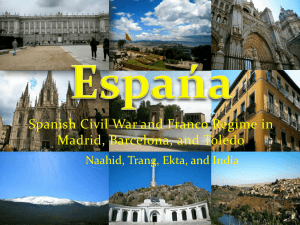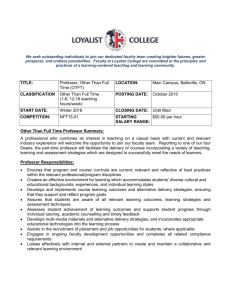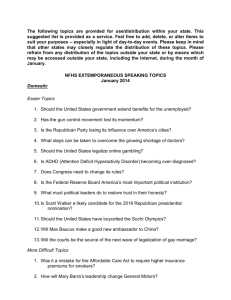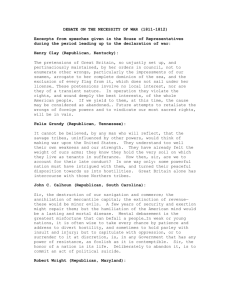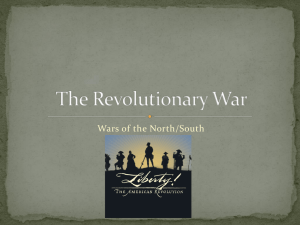Anthony Gokianluy
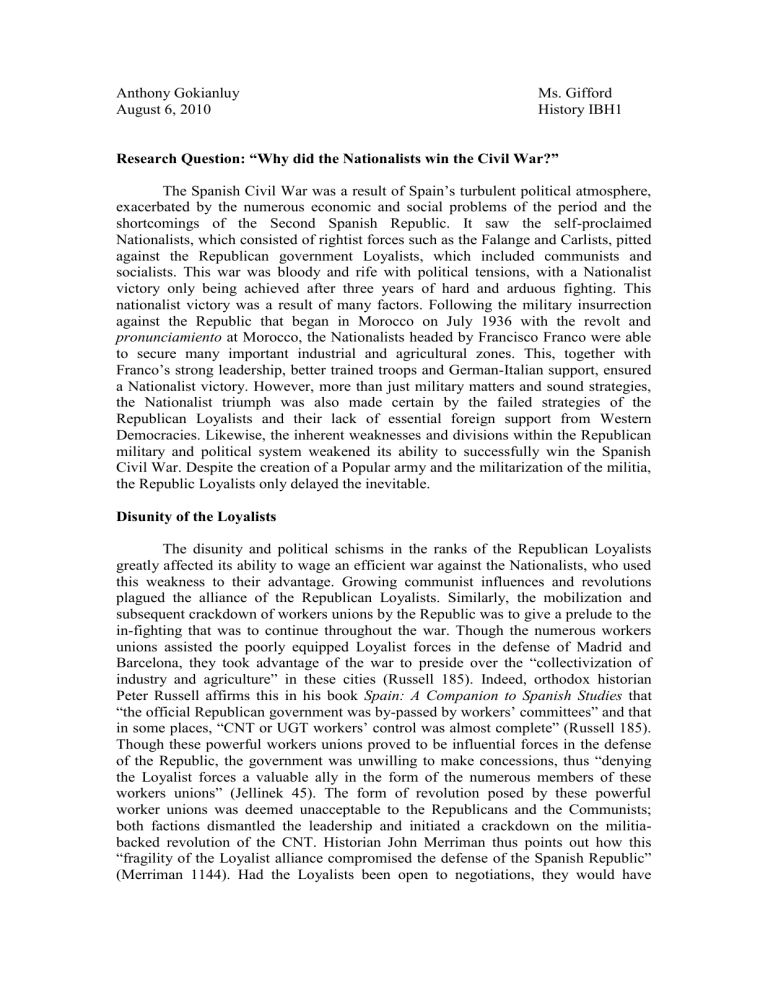
Anthony Gokianluy
August 6, 2010
Ms. Gifford
History IBH1
Research Question: “Why did the Nationalists win the Civil War?”
The Spanish Civil War was a result of Spain’s turbulent political atmosphere, exacerbated by the numerous economic and social problems of the period and the shortcomings of the Second Spanish Republic. It saw the self-proclaimed
Nationalists, which consisted of rightist forces such as the Falange and Carlists, pitted against the Republican government Loyalists, which included communists and socialists. This war was bloody and rife with political tensions, with a Nationalist victory only being achieved after three years of hard and arduous fighting. This nationalist victory was a result of many factors. Following the military insurrection against the Republic that began in Morocco on July 1936 with the revolt and pronunciamiento at Morocco, the Nationalists headed by Francisco Franco were able to secure many important industrial and agricultural zones. This, together with
Franco’s strong leadership, better trained troops and German-Italian support, ensured a Nationalist victory. However, more than just military matters and sound strategies, the Nationalist triumph was also made certain by the failed strategies of the
Republican Loyalists and their lack of essential foreign support from Western
Democracies. Likewise, the inherent weaknesses and divisions within the Republican military and political system weakened its ability to successfully win the Spanish
Civil War. Despite the creation of a Popular army and the militarization of the militia, the Republic Loyalists only delayed the inevitable.
Disunity of the Loyalists
The disunity and political schisms in the ranks of the Republican Loyalists greatly affected its ability to wage an efficient war against the Nationalists, who used this weakness to their advantage. Growing communist influences and revolutions plagued the alliance of the Republican Loyalists. Similarly, the mobilization and subsequent crackdown of workers unions by the Republic was to give a prelude to the in-fighting that was to continue throughout the war. Though the numerous workers unions assisted the poorly equipped Loyalist forces in the defense of Madrid and
Barcelona, they took advantage of the war to preside over the “collectivization of industry and agriculture” in these cities (Russell 185). Indeed, orthodox historian
Peter Russell affirms this in his book Spain: A Companion to Spanish Studies that
“the official Republican government was by-passed by workers’ committees” and that in some places, “CNT or UGT workers’ control was almost complete” (Russell 185).
Though these powerful workers unions proved to be influential forces in the defense of the Republic, the government was unwilling to make concessions, thus “denying the Loyalist forces a valuable ally in the form of the numerous members of these workers unions” (Jellinek 45). The form of revolution posed by these powerful worker unions was deemed unacceptable to the Republicans and the Communists; both factions dismantled the leadership and initiated a crackdown on the militiabacked revolution of the CNT. Historian John Merriman thus points out how this
“fragility of the Loyalist alliance compromised the defense of the Spanish Republic”
(Merriman 1144). Had the Loyalists been open to negotiations, they would have
gained a greater presence in Spain and their armies would have been better equipped to fight against a common enemy.
The communists themselves caused many difficulties from within the ranks of the Loyalists, openly purging members of POUM (Worker’s Party of Marxist
Unification) and withholding supplies and ammunition from allied anarchist and socialist units (Russell 186). George Orwell’s Homage to Catalonia even gives an account of the divisions between the major political factions on the Loyalist side, eclipsed by the damaging role of the communists. In May 1937, a “civil war within a civil war” saw the Socialists and Communists fight street battles with the Anarchists and Trotskyites on the streets of Barcelona. The growth of the Communist Party as a result of it being the conduit for weapons and materials coming from the USSR became a serious problem for the Republican Loyalists. It was even said that “these zealots made every effort to penetrate and control the government” (Crow 321). The
300,000 member strong Communists, in a bid to gain power in the government and push aside the powerful workers unions also ousted Largo Caballero and installed
Juan Negrin as Prime Minister. By 1937, Communist domination of the Loyalist army was assured; the army was subsequently used to “ruthlessly eliminate political enemies”. Such political in-fighting greatly weakened Loyalist morale. By 1939, the schisms within the Republican side became more acute, with an isolated “civil war” breaking out on the streets of Madrid between the Communists, who wanted to continue the fight, and the anti-Communists. Again, orthodox historian Peter Russell describes the Republican side, as a result of Communist actions, as “bedeviled by acute party divisions”. However, revisionist historian Irving Werstein, an ardent supporter of Communist leader La Pasionaria (Dolores Ibárruri), states in his book
The Cruel Years: The Story of the Spanish Civil War that the communist takeover of the army was needed in order to “unify the Republican and Loyalist resolve under a single banner” and that “[communist leadership] was responsible for the gallant defense of Madrid”. This is supported by historian Stephen Tonge who states that
“[The Communist] organization helped to keep the republic fighting. Inspired speeches from Dolores Ibárruri (La Pasionaria), the chief propagandist of the
Republic, raised morale”. However, it can be seen from the very onset of the war that the “Republic itself had already fallen apart because its national parliament was unable to govern” (Werstein 109) partly due to the political strife within its ranks and the influence the Communists imposed on the government as it gained strength and controlled the army. In contrast, Franco’s Nationalist forces did not face the political rifts and schisms that plagued the Republicans and Loyalists since the start of the
Civil War. Franco’s strong leadership among others ensured that the normally radical
Falangists and Carlists were incorporated into a unified movement, despite their oppositional tendencies. However, more than the widespread disunity encountered by the Republican Loyalists, the Nationalists’ strategies and successful campaigns can be deemed as more important factors in their victory.
Strategy of the Nationalists
In the initial phases of the civil war, the Nationalists had achieved some impressive tactical victories in the key cities of Castile, Galicia and Navarre. The
Nationalists targeted key cities and industrial sectors and used their influence to gain power in those cities. By the end of 1936, the Nationalist troops controlled the greater part of Andalucia, Extremadura, Toledo, Avila, Segovia, Valladolid, Burgos, Leon,
Galicia, a part of Asturias, Vitoria, San Sebastian, Navarra and Aragon, as well as the
Canary and Balearic Islands (refer to Figure 1) . The planned strategies and overall influence of the Nationalist forces ensured that it maintained its supremacy over the
Republican Loyalists.
Figure 1 taken from John Merriman, A History of Modern Europe: From the French
Revolution to the Present (Vol. 2), p.1142
From the start of the war it was already evident that the Republican Loyalist forces were at a severe disadvantage because of the strong Nationalist sentiments in the armed forces. Indeed, historian John Crow in his book Spain: The Root and the
Flower emphasizes how “almost the entire army, navy and air force joined the generals…the Civil Guard Corps also threw its considerable weight over to [the
Nationalist] side” (Crow 320). An alternative viewpoint is also offered by historian
Hugh Thomas, who downplays the overwhelming support given to the Nationalists by the military in stating that “half the army still remained loyal to the Republic’s cause…enough militia and
Asaltos were available to form the Popular Army” (54).
Despite the support given by forces still loyal to the Republic, it is generally agreed
that, compared to the numbers and foreign legions at General Franco’s command,
“fewer assault guards and only some small military groups remained loyal to the
Republic” (Crow 320). Though Republicans still held the centre, the industrial areas of the Basque Provinces, Catalonia and the Levante at the start of the war, the
Nationalists controlled the vital food-producing and agricultural areas which lowered morale in the Loyalist camps. By October 1937, the Nationalist forces were able to control most of the industrial zones of Asturias, the Basque Provinces and Santander where their initial uprisings had failed as a result of the workers unions. The capture of the northern industrial zones by 1937 “greatly strengthened [the Nationalist] front”.
The Republic Loyalists’ military and strategic blunders also helped the
Nationalist forces gain ground in most provinces. The failed diversionary battles of the Republican Loyalist army at Brunete and Aragon were costly and showed its incapacity to wage a successful offensive. Poor strategy on the part of Republican
Loyalists also hampered their ability to wage successful offensives. Orthodox historian Peter Russell attributes these defeats to the strength of the Nationalist army under General Franco and foreign support from Italian and German planes. However, in another interpretation, revisionist historian Frank Jellinek maintains that these defeats could have been prevented had the Communists and the Republican government not alienated or dismantled the powerful workers unions in those provinces (46). The decisiveness of Franco was instrumental in successfully breaking the Republican lines; in April 1938, the Nationalists were able to cut through the
Aragon front and reach the Mediterranean, cutting the Loyalist zone in two. Though the Loyalists were able to achieve a tactical breakthrough in the Battle of Ebro, they failed to exploit this effectively and lost any advantage gained. The final Nationalist campaign in Catalonia (1939) was relatively quick and Barcelona fell on January
1939. By 1937, the nationalists had reached the Atlantic Ocean, cutting off the
Loyalist Basque Provinces from France. By this time, the Loyalists “struggled along an imposing front that stretched from the Mediterranean to the Pyrenees; Catalonia was isolated from the remaining Loyalist territory” (Merriman 1146).
Propaganda of the Nationalists
The propaganda and campaigns of terror initiated by the Nationalists ensured continued support against the Loyalists and the unpopular Republic. The Nationalists made effective propaganda use of Loyalist atrocities and the growing power of communism; the pro-nationalist London Daily Mail even proclaims, “Reds Crucify
Nuns” (Merriman 1144). Indeed, the Republican Loyalists’ extensive use of a brutal secret police (the SIM) and their intolerance of opposition caused many to lose trust in the government and their communist allies. Propaganda thus played a key role in the Nationalist victory. The Nationalists argued that they represented the cause of
Christianity, order and Western civilization against communism. In each of the towns they conquered, the Nationalists embarked on a campaign of terror in order to root out
Republic Loyalists and ensure the cooperation of the citizens- over 100,000 Spaniards were killed in these brutal reprisals. Nationalists organized “Fiestas of Death” in bullrings, publicly killing Loyalists, Basque priests and numerous intellectuals (Crow
321). For propaganda purposes, the Nationalists even proclaimed that it was anti-
Communist to gather more support, especially towards the end of the civil war, when
Madrid had been left to the defense of the Communists. The Nationalists’ effective
propaganda was also assisted by the foreign support they received from the Germans and Italians, another crucial factor in success of the Nationalist campaigns.
Foreign Support of the Nationalists
For both sides, foreign support was integral for survival. In the case of the
Nationalists, German and Italian air and ground support were used to spearhead many successful campaigns. For the Republican Loyalists, however, key foreign aid from western democracies was almost non-existent, leaving Loyalists units poorly armed.
Even when foreign brigades and Soviet aid arrived, these were just “drops in the bucket” and, in some cases, only served to undermine unity as it was mostly the
Communist party that controlled these forces (Crow 321). Historian John Crow states,
“the Spanish Loyalists may have lost the war because friendly nations, such as the
United States and Britain, failed to sell their government the necessary munitions”.
Mr. Harry L. Stimson, a Republican who served as Secretary of War in President
Roosevelt’s cabinet, also notes that “if this Loyalist Government is overthrown, it is now evident that its defeat will be solely due to the fact that it has been deprived of its right to buy from us and from other friendly nations the munitions necessary for its defense” (Crow 323). For the most part, the Non-Intervention Agreement was adhered to by Western democracies such as the United States, France and Britain, countries that supported the Republican Loyalist effort. Many of these Western Democracies were interested in preventing war and were also prevented from sending aid by
Franco sympathizers in their respective governments. Even the United States president, Franklin Roosevelt was prevented from sending supplies to the Republic by
“well-organized political pressure” and by the powerful Catholic lobby (Crow 323).
Foreign aid to the Republic was also very inconsistent as a whole: The influx of
Soviet tanks, planes and technical advice dropped off in 1938 while foreign brigades were withdrawn in 1938. In some cases, the foreign support of the Republican
Loyalists even worked against them, increasing tensions and sowing more disunity.
More than 80% of the foreign brigades were Communists and this further diluted the control of the government and increased Communist influence over the army.
Furthermore, these Brigades were under the control of the Comintern and “operated outside the regular command of the Spanish Republican Army” (Tonge ¶ 5). These volunteers were also used by the Communists in internal struggles against their political enemies, the Socialists and the Anarchists, further widening the rifts within the Loyalist forces. The foreign aid requested by the Republic also drained Spain’s resources as most of the Spanish gold reserves (the fourth largest in the world) were sent to the USSR. The transfer of gold led to a rise in inflation on the Republican zone, further causing tensions with capitalists and businessmen, who threw their support behind the Nationalists (Crow 324).
It is also significant to mention that, from the very onset of the war, the low morale and poor training of the Loyalist forces contributed greatly to the victories of
Franco as the Civil War progressed. These inherent difficulties on the Loyalist side were evident in their failures and ultimate loss at the hands of the Nationalists on the battlefield. Indeed, writer George Orwell expressed his surprise at being issued a 1896
German Mauser rifle and having to organize a battle group from “illiterate peasants, shop clerks and foreign volunteers, many of whom could not speak Spanish and for whom the only word known in common was ‘comrade’ ” (Merriman 1145). Many of those who formed the Republican Popular Army were “raw recruits, improperly trained and poorly equipped” (Crow 321). In contrast, the Nationalist army consisted
of army regulars trained by adept military advisers and supported by Italian and
German planes and troops.
As a result of efficient communication and planning, the Nationalists almost immediately received German and Italian planes to transport their troops from
Morocco to the front lines. Their foreign support immediately determined the outcome of the war; “the Italians sent four full and heavily armed divisions to fight in
Spain, and the Germans a sizable air force and several thousand ground troops”
(Crow 321). The Portuguese, led by General Salazar, also sent 12,000 troops to aid the Nationalists. Antony Beevor writes in his book The Battle for Spain: The Spanish
Civil War 1936–
1939 that “the Italian contribution to the Nationalist cause was enormous and more general than the German contribution…this included a major role in the blockade of Republican ports”, he goes on to say that the German Condor
Legion was “the most efficient and influential assistance in Spain”. Mussolini and
Hitler’s pilots helped destroy key supply lines and German advisers trained nationalist pilots and military personnel (Merriman 1145). Nationalist air superiority was crucial to their success during the war when they encountered almost no resistance and were free to bomb Loyalist towns and supply routes. With these capable forces in their ranks, the Nationalists were poised to win the Civil War.
Conclusion
The Spanish Civil War exposed the inherent problems of the Second Spanish
Republic since its conception, particularly revealing the lack of support from factions in the military and in general Spanish society. These factors became crucial in the success of the initial Nationalist revolts in 1936 as well as in the fall of Madrid in early 1939. Similarly, foreign support from the Germans and Italians together with anti-Loyalist propaganda enabled Franco to wage an effective war against the
Republic forces. The Republic was already at a severe disadvantage from the very beginning with political tensions clouding its ability to act as a cohesive group. This, together with its growing unpopularity with many sectors in society and lack of key foreign support, made defeat inevitable. In contrast to the sad situation of the
Republic, the Nationalists under Franco were able to galvanize support from even the
Falange and the Carlists to achieve ultimate victory. Although more than 580,000 had died by the end of the Civil War in April 1, 1939, a new era for Spain had begun.
Works Cited:
Beevor, A. (2006). The Battle for Spain: The Spanish Civil War 1936–1939 . London:
Weidenfeld & Nicolson.
Crow, J. A. (1985). Spain: The Root and the Flower (3rd ed., pp. 318-325). Berkeley and Los Angeles: University of California Press.
Jellinek, F. (1938). The Civil War in Spain . London
Merriman, J. (2004). A History of Modern Europe: From the French Revolution to the
Present (Vol. 2, 2nd ed., pp. 1142-1146). New York: W.W. Norton and
Company, Inc.
Russell, P. E. (1973). Spain: A Companion to Spanish Studies (2nd ed., pp. 184-187).
London: Routledge.
Thomas, H. (1961). The Spanish Civil War (3rd ed.). London: Penguin Books.
Tonge, S. (2009, September 23). The Spanish Civil War . Retrieved June 15, 2010, from http://www.historyhome.co.uk/europe/spaincw.htm.
Werstein, I. (1969). The Cruel Years: The Story of the Spanish Civil War (pp. 39-98).
New York: Julian Messner.

